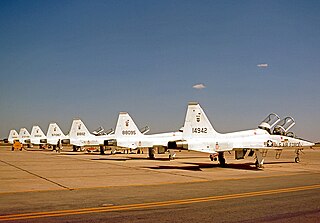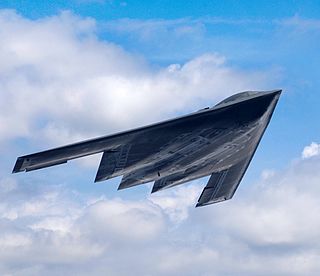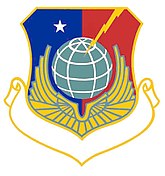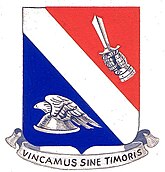
The 561st Weapons Squadron is a United States Air Force squadron assigned to the USAF Weapons School at Nellis Air Force Base, Nevada. The squadron was the last United States Air Force unit to fly the McDonnell F-4 Phantom II on operational missions. The last Republic F-105 Thunderchief shot down in the Vietnam War was from the 561st.

The 322d Air Expeditionary Group is a provisional United States Air Force unit assigned to the United States Air Forces in Europe. As a provisional unit, it may be activated or inactivated at any time.

The 29th Flying Training Wing is an inactive United States Air Force unit last based at Craig Air Force Base, Alabama. It was inactivated when Craig was closed when the Air Force reduced its pilot training program after the Vietnam War.

The 346th Bombardment Group is a former United States Army Air Forces unit. It was last assigned to the 316th Bombardment Wing at Kadena Airfield, Okinawa, where it was inactivated on 30 June 1946. The group was originally a heavy bomber training unit, but was inactivated in a general reorganization of Army Air Forces training units in 1944. It was reorganized as a Boeing B-29 Superfortress group later that year. It moved to Okinawa in 1945, but arrived too late to participate in combat.

The 449th Expeditionary Flying Training Squadron is a provisional United States Air Force unit assigned to the 322d Air Expeditionary Group. In 2008, it was converted to an expeditionary unit on provisional status for activation by Air Combat Command any time after 28 October 2008. Its current status is undetermined.

The 450th Expeditionary Flying Training Squadron is a provisional United States Air Force unit assigned to the 322d Air Expeditionary Group. In 2008 it was converted to an expeditionary unit on provisional status for activation by Air Combat Command any time after 28 October 2008. Its current status is undetermined.

The 560th Flying Training Squadron is part of the 12th Flying Training Wing of the United States Air Force based at Randolph Air Force Base, Texas. It operates the Northrop T-38 Talon.

The 42d Flying Training Squadron is an inactive United States Air Force unit, last assigned to Air Training Command at Columbus AFB, Mississippi, where it was inactivated on 15 December 1991.

The 867th Attack Squadron is an active United States Air Force unit. It was reactivated at Creech Air Force Base, Nevada, on 10 September 2012 as a remotely piloted aircraft squadron.

The 831st Bombardment Squadron was a squadron of the United States Army Air Forces. It was activated in 1942 as the 516th Bombardment Squadron and flew antisubmarine missions off the Atlantic coast as the 11th Antisubmarine Squadron. Later, it saw combat in the Mediterranean Theater of Operations as a Consolidated B-24 Liberator unit, where it earned a Distinguished Unit Citation during the strategic bombing campaign against Germany. Following V-E Day, the squadron returned to the United States and was inactivated at Sioux City Army Air Base, Iowa on 20 August 1945.

The 835th Bombardment Squadron is an inactive United States Army Air Forces unit. It was activated in January 1941 as the 80th Bombardment Squadron and equipped with Douglas A-20 Havoc light bombers. Following the attack on Pearl Harbor the squadron began to fly antisubmarine patrols off the Atlantic coast and over the Caribbean Sea, becoming the 9th Antisubmarine Squadron.

The 450th Fighter-Day Group is an inactive United States Air Force unit. It was last assigned to the 450th Fighter-Day Wing of Tactical Air Command (TAC) at Foster AFB, Texas. It was inactivated on 11 December 1957.

The 512th Fighter Squadron is an inactive United States Air Force unit. Its last assignment was with the 86th Fighter Wing at Ramstein Air Base, Germany, where it was inactivated September 1994.

The 388th Operations Group is the flying component of the 388th Fighter Wing, assigned to the Air Combat Command Twelfth Air Force. The group is stationed at Hill Air Force Base, Utah.

The 526th Bombardment Squadron is an inactive United States Air Force unit. It was last assigned to the 4042d Strategic Wing at K. I. Sawyer Air Force Base, Michigan, where it was inactivated on 1 February 1963 when Strategic Air Command replaced its MAJCON wings with wings that could continue a heritage.

The 325th Weapons Squadron is a United States Air Force unit assigned to the USAF Weapons School, stationed at Whiteman Air Force Base, Missouri.

The 451st Flying Training Squadron is an active United States Air Force unit. Its assigned to the 479th Flying Training Group, stationed at NAS Pensacola, Florida.

The 454th Flying Training Squadron is an inactive United States Air Force unit. Its was last assigned to the 323d Flying Training Wing at Mather Air Force Base, California, where it was inactivated on 1 October 1993.

The 455th Flying Training Squadron is a United States Air Force unit of Air Education and Training Command. It was most recently activated at NAS Pensacola as part of the 479th Flying Training Group, where it trains Combat Systems Officers with the Raytheon T-6 Texan II.

The 920th Air Refueling Squadron is an inactive United States Air Force unit. It was last assigned to the 379th Bombardment Wing at Wurtsmith Air Force Base, Michigan where it was inactivated on 30 September 1992.

 (approved 25 September 1973) [2] [note 1]
(approved 25 September 1973) [2] [note 1] 


























